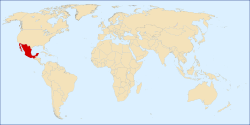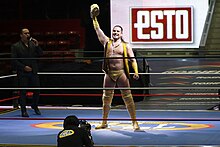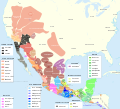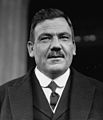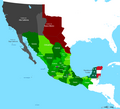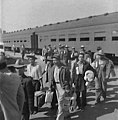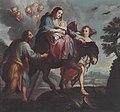Portal:Mexico
|
The Temple of Warriors at Chichen Itza, Mexico
¡Bienvenido! Welcome to the Mexico portal
Mexico, officially the United Mexican States, is a country in the southern portion of North America. It covers 1,972,550 km2 (761,610 sq mi), making it the world's 13th-largest country by area; with a population of almost 130 million, it is the 10th-most-populous country and the most populous Spanish-speaking country. Mexico is organized as a federal constitutional republic comprising 31 states and Mexico City, its capital. It shares land borders with the United States to the north, with Guatemala and Belize to the southeast; as well as maritime borders with the Pacific Ocean to the west, the Caribbean Sea to the southeast, and the Gulf of Mexico to the east.
This is a Featured article, which represents some of the best content on English Wikipedia.
The Grass Fight was a small battle during the Texas Revolution, fought between the Mexican Army and the Texian Army. The battle took place on November 26, 1835, just south of San Antonio de Béxar in the Mexican region of Texas. The Texas Revolution had officially begun on October 2 and by the end of the month the Texians had initiated a siege of Béxar, home of the largest Mexican garrison in the province. Bored with the inactivity, many of the Texian soldiers returned home; a smaller number of adventurers from the United States arrived to replace them. After the Texian Army rejected commander-in-chief Stephen F. Austin's call to launch an assault on Béxar on November 22, Austin resigned from the army. The men elected Edward Burleson their new commander-in-chief. On November 26, Texian scout Deaf Smith brought news of a Mexican pack train, accompanied by 50–100 soldiers, that was on its way to Bexar. The Texian camp was convinced that the pack train carried silver to pay the Mexican garrison and purchase supplies. Burleson ordered Colonel James Bowie to take 45–50 cavalry and intercept the train. An additional 100 infantry followed. On seeing the battle commence, Mexican General Martín Perfecto de Cos sent reinforcements from Bexar. The Texans repulsed several attacks by Mexican soldiers, who finally retreated to Bexar. When the Texians examined the abandoned pack train they discovered that, instead of silver, the mules carried freshly cut grass to feed the Mexican Army horses. Four Texians were injured, and historian Alwyn Barr states that three Mexican soldiers were killed, although Bowie and Burleson initially claimed the number was much higher. (Full article...)Selected article - The 1970 FIFA World Cup was the ninth edition of the FIFA World Cup, the quadrennial international football championship for men's senior national teams. Held from 31 May to 21 June in Mexico, it was the first World Cup tournament held outside Europe and South America, and also the first held in North America. Teams representing 75 nations from all six populated continents entered the competition, and its qualification rounds began in May 1968. Fourteen teams qualified from this process to join host nation Mexico and defending champions England in the 16-team final tournament. El Salvador, Israel and Morocco made their debut appearances at the final stage. In the tournament final, Brazil won 4–1 against Italy, another FIFA two-time champion (and UEFA Euro 1968 winner). Brazil also overcame another two-time champion and South American champions Uruguay, by 3–1 in the semi-final, and defending champions England 1–0 in the group stage as they were also eliminated by West Germany in the quarter-finals. This is currently the only time that the winning team defeated the European and South American champions alongside the tournament's defending champions. (Full article...)Selected picture Mural by Diego Rivera, of the Pre-Columbian Aztec city of Tenochtitlan.Palacio Nacional, Mexico City. image credit: Wolfgang Sauber/freedom of panorama
This is a Good article, an article that meets a core set of high editorial standards.
Miguel Ángel Chávez Velasco (born August 18, 1988), better known by his ring name Ángel de Oro (Spanish for "Angel of Gold" or "Golden Angel"), is a Mexican professional wrestler who works for the Mexican wrestling promotion Consejo Mundial de Lucha Libre (CMLL). He is currently a double champion in CMLL, as he is the Mexican National Light Heavyweight Champion and the World Tag Team Champion, both in his first reign. In 2018, he was defeated in a Luchas de Apuestas (mascara contra mascara; "mask vs. mask") match by El Cuatrero, and was forced to unmask and be identified. He is a second-generation luchador, the son of Apolo Chávez and the brother of the luchador Niebla Roja, who also works for CMLL. From 2008 to 2011, Ángel de Oro was part of a group called Los Ángeles Celestiales ("The Celestial Angels") alongside his brother (then billed as Ángel de Plata) and Ángel Azteca Jr., but after his brother changed his ring persona, that group has been phased out. After many years of portraying a tecnico ("Good guy") wrestling character, Ángel de Oro and his brother turned rudo and aligned themselves with El Terrible, eventually forming Los Nuevos Ingobernables. (Full article...)Selected biography -Francisco "Pancho" Villa (/ˈviːə/ VEE-ə, also US: /ˈviːjɑː/ VEE-yah; Spanish: [ˈbiʎa]; born José Doroteo Arango Arámbula, 5 June 1878 – 20 July 1923) was a Mexican revolutionary and general in the Mexican Revolution. He was a key figure in the revolutionary movement that forced out President Porfirio Díaz and brought Francisco I. Madero to power in 1911. When Madero was ousted by a coup led by General Victoriano Huerta in February 1913, Villa joined the anti-Huerta forces in the Constitutionalist Army led by Venustiano Carranza. After the defeat and exile of Huerta in July 1914, Villa broke with Carranza. Villa dominated the meeting of revolutionary generals that excluded Carranza and helped create a coalition government. Emiliano Zapata and Villa became formal allies in this period. Like Zapata, Villa was strongly in favor of land reform, but did not implement it when he had power. At the height of his power and popularity in late 1914 and early 1915, the U.S. considered recognizing Villa as Mexico's legitimate authority. Civil war broke out when Carranza challenged Villa. Villa was decisively defeated by Constitutionalist general Álvaro Obregón in summer 1915, and the U.S. aided Carranza directly against Villa in the Second Battle of Agua Prieta in November 1915. Much of Villa's army left after his defeat on the battlefield and because of his lack of resources to buy arms and pay soldiers' salaries. Angered at the U.S. aid to Carranza, Villa conducted a raid on the border town of Columbus, New Mexico to goad the U.S. into invading Mexico in 1916. Despite a major contingent of soldiers and superior military technology, the U.S. failed to capture Villa. When Carranza was ousted from power in 1920, Villa negotiated an amnesty with interim President Adolfo de la Huerta and was given a landed estate, on the condition he retire from politics. Villa was assassinated in 1923. Although his faction did not prevail in the Revolution, he was one of its most charismatic and prominent figures. (Full article...)
In the news
Selected fare or cuisine -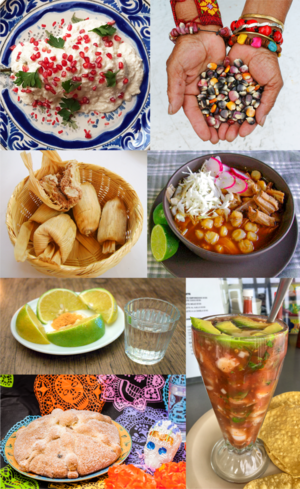 Mexican cuisine consists of the cooking cuisines and traditions of the modern country of Mexico. Its earliest roots lie in Mesoamerican cuisine. Its ingredients and methods begin with the first agricultural communities such as the Olmec and Maya who domesticated maize, created the standard process of nixtamalization, and established their foodways. Successive waves of other Mesoamerican groups brought with them their cooking methods. These included: the Teotihuacanos, Toltec, Huastec, Zapotec, Mixtec, Otomi, Purépecha, Totonac, Mazatec, Mazahua, and Nahua. With the Mexica formation of the multi-ethnic Triple Alliance (Aztec Empire), culinary foodways became infused (Aztec cuisine). Today's food staples native to the land include corn (maize), turkey, beans, squash, amaranth, chia, avocados, tomatoes, tomatillos, cacao, vanilla, agave, spirulina, sweet potato, cactus, and chili pepper. Its history over the centuries has resulted in regional cuisines based on local conditions, including Baja Med, Chiapas, Veracruz, Oaxacan, and the American cuisines of New Mexican and Tex-Mex. (Full article...)
General imagesThe following are images from various Mexico-related articles on Wikipedia.
CategoriesTopicsRelated portalsWikiProjectYou are invited to participate in WikiProject Mexico, a WikiProject dedicated to developing and improving articles about Mexico. Associated WikimediaMore portals | ||||||||||




